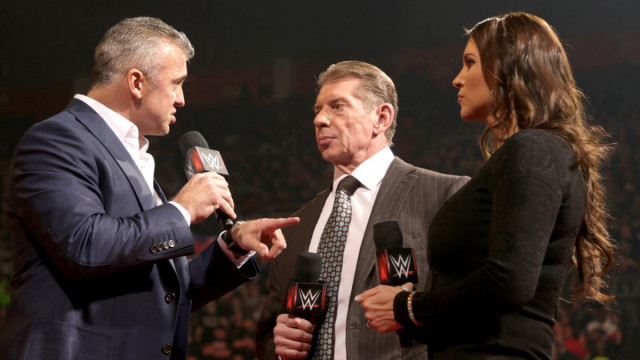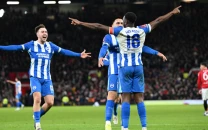Will revamping help WWE return to its former glory?
Ten years from now, the Cenas and the Randy Ortons won’t be there to carry WWE forward

WWE schemers need to relearn the art of creating stars. PHOTO COURTESY: WWE.COM
 PHOTO COURTESY: WWE.COM
PHOTO COURTESY: WWE.COMHaving swallowed its biggest rival, WWE became an even bigger fish but the only one in a shrinking pond as the enemy that forced WWE to be on their toes existed no more. Hence, it was no surprise that after WCW’s demise, things started going downhill for WWE.
Pakistani boy suffering from muscular dystrophy meets John Cena
The Attitude Era was followed by the Ruthless Aggression Era (2002-2008), which offered quality storylines and better wrestling matches (as opposed to the more gimmicky, flashy entertainment that fuelled the previous era). However, the ratings took a massive hit. Things became even worse when WWE entered the PG Era in 2008 in the wake of a gruesome match between Chris Jericho and Shawn Michaels. Suddenly, blood and chair shots to the head were banned. The unfortunate deaths of Chris Benoit and Eddie Guerrero also played a part in WWE's toning down of real violence to protect their employees as part of its new wellness policy.
One positive that did come out of those testing times was the emergence of John Cena. The former bodybuilder-turned-wrestler rose to immense popularity and earned WWE ships load of money even though there was still no respite on the ratings front.
 PHOTO COURTESY: WWE.COM
PHOTO COURTESY: WWE.COMThe John Cena formula became WWE's go-to play, which would begin with The Cenation Leader getting destroyed by a new heel (the bad guy), losing a match or two due to interference and dirty tactics before ending the feud by winning it all back.
WWE repeated the trick and cashed Cena's stardom for a decade before fans were finally fed up. It had now reached the point where the company poster boy laying waste to all potential future stars was not interesting anymore.
The signs of fans' ennui had been there all along, yet the WWE turned a blind eye to it. CM Punk called it years ago. His famous “pipe bomb” on a Monday Night Raw in 2011, when he called a spade a spade, was perhaps the most truthful promo in wrestling history. Punk did in a few minutes what every WWE superstar had been dying to say to the company's creative team for years: Give them a chance to be the next moneymaker and stop shoving John Cena down everybody’s throats.
Three years later, Punk quit over his boiling frustration and a neglected staph injury which, according to his doctor, could have taken his life. This is when the inertia, at least among the fans, finally gave in.
 PHOTO COURTESY: WWE.COM
PHOTO COURTESY: WWE.COMIt was now the fans fighting against the promotion. Where the officials wanted the returning Batista to main-event the Wrestlemania 30, the fans wanted their beloved Daniel Bryan. The uprising saw the fans completely take over shows every week, chanting for Bryan and protesting when he was screwed over.
Devoid of a choice, the writers at last relented, inserted Bryan into the main event and let him win too. A month later, Bryan got injured and had to relinquish the title. And with that, things were back to square one.
Wrestlers to work as brand ambassadors for orphanage
Meanwhile, WWE NXT — the company's new developmental territory which had been making waves in all of wrestling industry since 2012 — offered what the WWE’s main shows Raw and Smackdown couldn’t, that is amazing wrestling and solid storylines.
Under Triple H’s leadership, NXT became a brand in itself. And perhaps to please the so-called Internet Wrestling Community (IWC) or impress the higher-ups, the Game started hiring wrestlers from independent wrestling circuits, bringing in big names from all promotions worldwide. For serious wrestling fans, NXT quickly became the brand to watch, while Raw and Smackdown dwindled into mediocrity. In retrospective, this would not have been possible if it weren’t for CM Punk quitting WWE in 2014.
 PHOTO COURTESY: WWE.COM
PHOTO COURTESY: WWE.COMAnother thing that NXT had on its glamorous rivals was quality women’s wrestling. In the years following the legendary Trish Stratus and Lita’s retirement, WWE women’s division faded fast. On the other hand, NXT boasted female athletes who could wrestle, not just look the part. The company had previously began hire models, rather than female wrestlers, leading to a massive decline in public interest in the division. NXT brought in women like Sasha Banks, Bayley, Charlotte (the legendary Ric Flair’s daughter) and Becky Lynch, who performed as well as, or at times, even supplanted their male counterparts.
Wrestlers to work as brand ambassadors for orphanage
WWE shows were filled with NXT call-ups and wrestlers who truly cared about performing in-ring, yet something was missing. The company tried projecting Roman Reigns, one of the first superstars from the NXT to be called up, as the next John Cena. But despite two years of forcing Reigns to be the new face of WWE, the fans rejected him as his success came at the expense of their beloved Bryan. The same Bryan from whom the company asked so much and set such an exhausting schedule that he kept getting injured and eventually retired earlier this year.
In the bigger picture, the problem with WWE wasn’t Roman Reigns or Daniel Bryan. It was the writers and the authorities telling the wrong stories, or the right stories in the wrong manner. Wrestlers who were great performers and whom the crowd loved to cheer on were forced to take a back seat in favour of those who the authorities wanted to push.
 PHOTO COURTESY: WWE.COM
PHOTO COURTESY: WWE.COMRaw, WWE’s flagship show, which used to hit five or six on Nielsen ratings for fun back in 1999, could now muster only two or three. Raw’s ratings also suffered with the show going from two to three hours in July 2012. That left out Smackdown as an afterthought while the company focused on Raw.
Meet the first Pakistani wrestler to compete in WWE
Nevertheless, 2016 will be remembered as the year the company decided to revamp their shows to boost audience. In an attempt to recapture lost interest, WWE decided to bring back brand extension draft in July. The two shows now featured distinct rosters. The corner had been turned, and a new, promising era was finally underway.
It is also interesting to note that Shane McMahon was brought back around Wrestlemania 32 to develop interest in the biggest show of the year which until then had suffered from a lack of star power due to injuries to Cena and Rollins. With desperation creeping in, WWE needed stars who could carry the show they were promoting as the biggest of all time..
 PHOTO COURTESY: WWE.COM
PHOTO COURTESY: WWE.COMWith Shane, to the surprise of WWE, receiving a roaring response from the audience, he stuck around even after losing to the Undertaker at ‘Mania. But in another trademark illogical yet crowd-pleasing rejig, Shane, along with his sister Stephanie McMahon, was handed the Raw reigns.
The sibling rivalry soon kicked in and saw Shane relegated to become the new commissioner of Smackdown, and he chose the true people’s champ Daniel Bryan (sorry Dwayne) as his General Manager.
We're into August 2016 and the WWE has changed completely. A divided roster, new theme songs, sets and graphics for each brand, new faces — it's clear that WWE has learnt from its mistakes and regained some lost ground. Superstars such as Dean Ambrose, Dolph Ziggler, Bray Wyatt, AJ Styles, Seth Rollins and NXT alumni a la Finn Balor are being given prominent storylines and contending for world titles. Meanwhile, Cena-type big name veteran are being used to turn aforementioned crowd favourites into new stars.
 PHOTO COURTESY: WWE.COM
PHOTO COURTESY: WWE.COMWhile the short term signs point in the right direction, it remains to be seen whether these tactics will also prove beneficial in the long run and help this WWE emulate the WWE of the old.
Ten years from now, the Cenas and the Randy Ortons won’t be there to carry WWE. To prepare for that day, the company schemers need to relearn the art of creating stars, which they used to for fun back in the day. Names such as Kevin Owens, Balor, Sami Zayn, Cesaro, Rollins and Ambrose are the stars that will undoubtedly carry WWE forward unless the company fails them like they have failed countless others before them.



















COMMENTS
Comments are moderated and generally will be posted if they are on-topic and not abusive.
For more information, please see our Comments FAQ